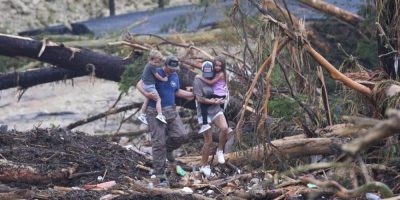
"There's more work that's needed on radar tools for the forecasters that issue the warnings," according to David Sills, executive director of the Northern Tornadoes Project at Western University in London, Ont.
But compared to May 31, 1985, when a violent tornado blasted through parts of Barrie, Sills says the data forecasters have now is much better than 38 years ago.
"In fact, with that storm, a new Doppler radar had just been installed at Environment Canada, and it covered that. This was the first time that a tornado had been sampled by Doppler radar in Canada, so we learned quite a bit from that experience."
Sills says there are new radars that have been installed across the country that are capable of earlier detection of tornadic storms.
"There is still work to do in order to get those tornado warnings out, and out earlier," he adds. "It's one of the most challenging things a forecaster will face, and a lot of it is because it is fairly rare. Some forecasters will go through their entire careers without ever having issued a warning for a significant tornado. The main thing is training and simulations and making sure that forecasters get some confidence with these kinds of rare events before they actually happen on their shift."
The 1985 tornado that struck Barrie killed eight people and injured hundreds, and of the 605 homes in the path of the twister, about one-third were rendered uninhabitable. The tornado was classified as an EF-4 with a wind speed of between 267–322 kilometres per hour.
Bob Chapple remembers...
The tornado blew through late on a Friday afternoon, and many businesses that were in the path of the tornado had sent workers home early due to a power outage, or the death and injury toll could have been much higher.
Sills says the big challenge with tornado warnings is the short amount of time that forecasters have to act.
"We need better tools, better training in order for those forecasters to have the confidence to really push that button when they see the first sign of something that looks like it could be tornadic. Obviously, they have to act very quickly because the time from seeing a feature on radar to the tornado actually causing damage is sometimes only minutes."
The tornado that hit a portion of south Barrie around Prince William Way in 2021 was an example of what Sills is talking about.
"The warning (tornado) was issued a bit late as far as that damage that was caused. People were walking out of their homes after the damage had happened, and they got the warning on their phones."
But despite all the additional tools for meteorologists, Sills says the public has a responsibility to be mindful of weather watches and warnings.
"When a tornado watch is issued, meaning the ingredients are there, and it may or may not happen, but it's possible, the thing you can do is close your garage door, close your windows, make your building envelope, and seal that envelope, so the wind is not getting into your home, and remove things that could become missiles and cause damage to either your house or someone else's house."
If there is a tornado warning, Sills says people should get away from windows and doors and out of the way of any debris, and "don't be standing there taking video like you see a lot on social media."
A point of frustration for Sills and his team is the lack of action on the part of the province to change the Ontario Building Code that would require new homes to be installed with hurricane straps, something that was bandied about at Barrie City Council soon after the 2021 tornado.
"Western engineering has been pushing for hurricane straps for I think about a decade now," says Sills. "The Barrie event made a good case for hurricane straps, and it was really great to see Barrie City Hall take that on and make recommendations for changes to the building code."
Sills says hurricane straps are very inexpensive as far as comparing them to the total cost of the home.
"There are some builders that do it voluntarily and are building tornado-resilient subdivisions, but the end objective would be to get that right in the building code, so it's done everywhere that tornadoes happen."
He says hurricane straps are small pieces of metal that are designed to hold the roof onto the walls.
"In Canada, we have built for decades and decades homes that can withstand a lot of snow on the roof, but there hasn't been much in the way in the building code to prevent roofs from coming off. If you have a poorly connected roof, then that roof can come off and then all of your contents in your home are at risk of being destroyed."
Sills says hurricane straps can keep the roof on for tornadoes that are EF-2 strength, and which he notes is 90 per cent of the tornadoes in Canada, including the 2021 Barrie storm, where the wind speed reached 210 kilometres per hour.
When it comes to tornadoes, is Barrie in the bullseye?
"The Great Lakes have a big influence on where thunderstorms develop and tornadoes in southern Ontario. We end up with this alley, you can call it, that basically rides along the 401 and to the north of it, maybe 100 kilometres to the north," Sills explains. "Windsor to Sarnia and then just north of Toronto to Barrie and extending to eastern Ontario. We definitely see that Barrie is right in the alley, and certainly, there's been a number of big tornado events in the Barrie area, and that is certainly expected to continue."
Banner image: 1985 Barrie tornado/John Mahler





